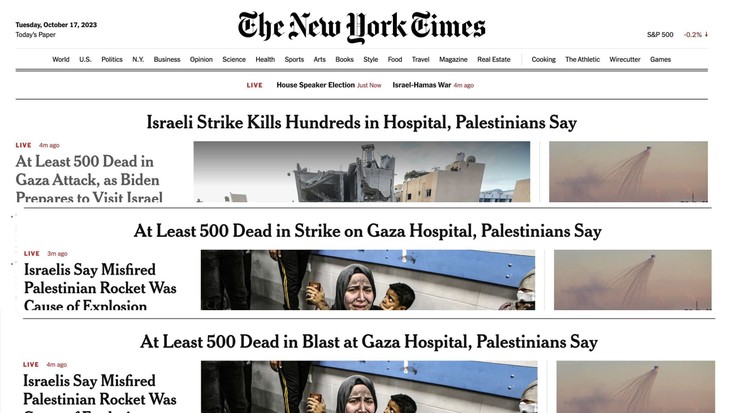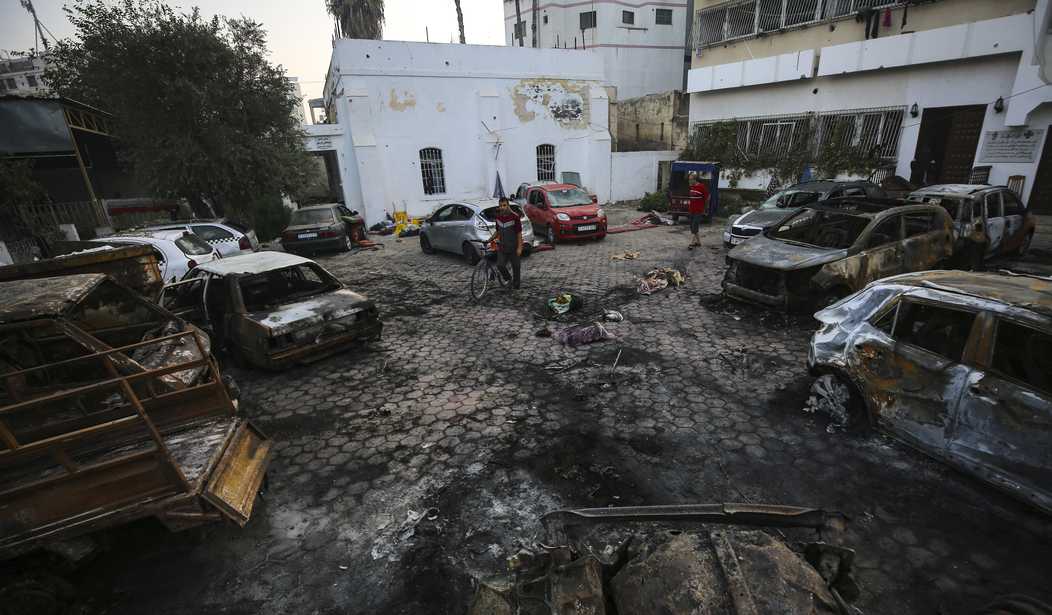On October 17, the New York Times decided that the Hamas public relations department was a beacon of truth and published — almost verbatim, we assume — a news release on what was referred to as an “Israeli attack” on a hospital in Gaza.

It may have been almost verbatim because there wasn’t a hint of doubt in the report that presented as fact what the “Palestinians said” about the hospital explosion.
As many observers have pointed out, the report didn’t originate with the Palestinian civil authorities but with the Gaza Ministry of Health, which Hamas runs. The Times simply regurgitated Hamas propaganda.
The Times report was false “on every level,” according to The Free Press’s Bari Weiss.
The bomb was not Israeli, but a Palestinian Islamic Jihad rocket aimed at Israel that misfired. The bomb didn’t hit the hospital, but the hospital parking lot. Hamas claimed that 500 people were killed, but a senior European intelligence source told AFP he thought the death toll was under 50; U.S. intelligence estimates that the number stands between 100 and 300.
Here we are a week later and after a firestorm of controversy, the Times snuck in an “Editor’s Note.” You should know that a Times “Editor’s Note” is usually a sentence or two clarifying a point or apologizing for getting something wrong.
This one is a 300-word apologia that tries its best not to apologize.
The Times’s initial accounts attributed the claim of Israeli responsibility to Palestinian officials, and noted that the Israeli military said it was investigating the blast. However, the early versions of the coverage — and the prominence it received in a headline, news alert and social media channels — relied too heavily on claims by Hamas, and did not make clear that those claims could not immediately be verified. The report left readers with an incorrect impression about what was known and how credible the account was.
Of course. Anyone could make the mistake of taking the word of a terrorist group at face value, right?
Given the sensitive nature of the news during a widening conflict, and the prominent promotion it received, Times editors should have taken more care with the initial presentation, and been more explicit about what information could be verified. Newsroom leaders continue to examine procedures around the biggest breaking news events — including for the use of the largest headlines in the digital report — to determine what additional safeguards may be warranted.
The problem is that there are so many falsehoods and half-truths in their initial reports that their readers are owed a full-blown apology for accepting the facts presented by baby-killers as gospel truth. It should be noted that as of now, no effort has been made to correct the record — despite the fact there are still no independent facts that verify the Hamas side of the story. There are not 500, 300, or even 100 bodies recovered from the blast — a blast that happened in the parking lot of the hospital and not in the hospital itself.
Rep. Rashida Tlaib still has her initial tweet up blaming Israel for the explosion.
Israel just bombed the Baptist Hospital killing 500 Palestinians (doctors, children, patients) just like that. @POTUS this is what happens when you refuse to facilitate a ceasefire & help de-escalate.
Your war and destruction only approach has opened my eyes and many… https://t.co/mZYoifT7bj
— Rashida Tlaib (@RashidaTlaib) October 17, 2023
Tlaib said in an interview on Monday, “I cannot uncritically accept Israel’s denials of responsibility as fact.” Changing the narrative at this point is impossible. It’s set in stone. And the New York Times owes its readers a lot more than an “Editor’s Note” in promoting what amounts to a blood libel against the Israeli government.










Join the conversation as a VIP Member